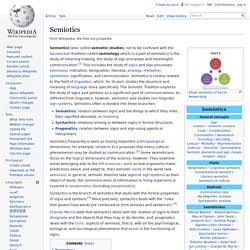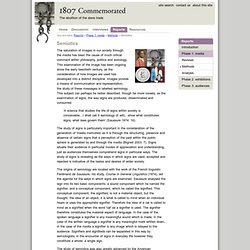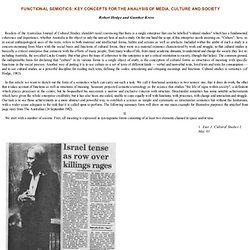

Semiotics: the study of signs. 1. Section 1: Semiotics, Semiology, Sign and Saussure Lecture. 8. Semiotics and Structuralism. Introduction. Daniel Chandler Introduction If you go into a bookshop and ask them where to find a book on semiotics you are likely to meet with a blank look. Even worse, you might be asked to define what semiotics is - which would be a bit tricky if you were looking for a beginner's guide. It's worse still if you do know a bit about semiotics, because it can be hard to offer a simple definition which is of much use in the bookshop. If you've ever been in such a situation, you'll probably agree that it's wise not to ask.
Assuming that you are not one of those annoying people who keeps everyone waiting with your awkward question, if you are searching for books on semiotics you could do worse than by starting off in the section. Thus wrote the Swiss linguist Ferdinand de Saussure (1857-1913), a founder not only of linguistics but also of what is now more usually referred to as semiotics (in his , 1916). Semiotics is not widely institutionalized as an academic discipline.
Introduction. Semiotics. Semiotics frequently is seen as having important anthropological dimensions; for example, Umberto Eco proposes that every cultural phenomenon may be studied as communication.[2] Some semioticians focus on the logical dimensions of the science, however.

They examine areas belonging also to the life sciences – such as how organisms make predictions about, and adapt to, their semiotic niche in the world (see semiosis). In general, semiotic theories take signs or sign systems as their object of study: the communication of information in living organisms is covered in biosemiotics (including zoosemiotics). Syntactics is the branch of semiotics that deals with the formal properties of signs and symbols.[3] More precisely, syntactics deals with the "rules that govern how words are combined to form phrases and sentences".[4] Terminology[edit] Ferdinand de Saussure, however, founded his semiotics, which he called semiology, in the social sciences: History[edit] Formulations[edit] Branches[edit] Notes. Semiotics for Beginners by Daniel Chandler.
What is Semiotics Media Studies. Semiotics. SSMS-Nack. Semiotics - a method to study the media and how the abolition of slavery has been commemorated. You are here: Reports » Phase 1: media » Methods » Semiotics The saturation of images in our society through the media has been the cause of much critical comment within philosophy, politics and sociology.

This examination of the image has been ongoing since the early twentieth century, as the consideration of how images are used has developed into a distinct discipline. Images provide a means of communication and representation, the study of these messages is labelled semiology. This subject can perhaps be better described, though far more loosely, as the examination of signs, the way signs are produced, disseminated and consumed. 'A science that studies the life of signs within society is conceivable...I shall call it semiology (it will)...show what constitutes signs, what laws govern them' (Saussure 1974: 16).
The study of semiotics was also greatly advanced by the American philosopher Charles Pierce, who analysed the notion of signs to reveal underlying components. Semiotics - a method to study the media and how the abolition of slavery has been commemorated. Media and Semiotic Theory: Key Terms and Concepts. FUNCTIONAL SEMIOTICS: KEY CONCEPTS FOR THE ANALYSIS OF MEDIA, CULTURE AND SOCIETY. Readers of the Australian Journal of Cultural Studies shouldn't need convincing that there is a single enterprise that can be labelled "cultural studies" which has a fundamental coherence and importance, whether Australia is the object or only the unwary host of such a study.

On the one hand the scope of this enterprise needs insisting on. "Culture", here, as in social anthropological uses of the term, refers to both material and intellectual forms, habits and actions as well as artefacts. Included within the ambit of such a study is a concern stemming from Marx with the social basis and functions of cultural forms, their roots in a material existence characterized by work and struggle, so that cultural studies is basically a critical enterprise that connects with the efforts of many people, from many walks of life, from many academic domains, to understand and change the society they live in: including Australia, the so-called Lucky Country.
We start with a number of axioms. Semiotics (Documentary)